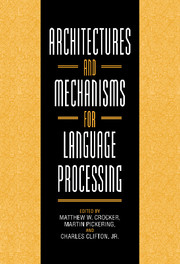Book contents
- Frontmatter
- Contents
- Contributors
- Preface
- 1 Architectures and Mechanisms in Sentence Comprehension
- Part I Frameworks
- 2 Evaluating Models of Human Sentence Processing
- 3 Specifying Architectures for Language Processing: Process, Control, and Memory in Parsing and Interpretation
- 4 Modeling Thematic and Discourse Context Effects with a Multiple Constraints Approach: Implications for the Architecture of the Language Comprehension System
- 5 Late Closure in Context: Some Consequences for Parsimony
- Part II Syntactic and Lexical Mechanisms
- Part III Syntax and Semantics
- Part IV Interpretation
- Author Index
- Subject Index
5 - Late Closure in Context: Some Consequences for Parsimony
Published online by Cambridge University Press: 03 October 2009
- Frontmatter
- Contents
- Contributors
- Preface
- 1 Architectures and Mechanisms in Sentence Comprehension
- Part I Frameworks
- 2 Evaluating Models of Human Sentence Processing
- 3 Specifying Architectures for Language Processing: Process, Control, and Memory in Parsing and Interpretation
- 4 Modeling Thematic and Discourse Context Effects with a Multiple Constraints Approach: Implications for the Architecture of the Language Comprehension System
- 5 Late Closure in Context: Some Consequences for Parsimony
- Part II Syntactic and Lexical Mechanisms
- Part III Syntax and Semantics
- Part IV Interpretation
- Author Index
- Subject Index
Summary
Introduction
We use language, amongst other things, to describe the world in which we live (whether the physical world or the mental equivalent). For us to be able to do this, there must exist an interdependence between the two – we must be able to map whatever representations are evoked by experiencing the world directly onto whatever representations are evoked by hearing (or reading) a description of that world. With respect to language acquisition, it is commonly believed that the interpretation of structure in language and of structure in the world are mutually constraining – without that mutual constraint we could not learn the meanings of verbs or the significance of different sentential structures (e.g., Fisher, Hall, Rakowitz, & Gleitman, 1994; Gleitman, Gleitman, Landau, & Wanner, 1988). Unless our language processing system somehow metamorphoses into an adult state that bears no relationship whatsoever to its younger self, adult sentence processing must respect the interdependence between sentences in the language and events in the world. The process of sentence interpretation is nothing more than the realization of that interdependence, and the realization of the mapping between sentential input and the mental world.
Ambiguity in the language complicates the mapping process, because it allows for more than one possible mapping. The question then is: On what basis do we determine which mapping is intended? On what basis are ambiguities in the language resolved? In this chapter I shall (re)consider this question as it applies to syntactic ambiguities.
- Type
- Chapter
- Information
- Architectures and Mechanisms for Language Processing , pp. 119 - 132Publisher: Cambridge University PressPrint publication year: 1999

